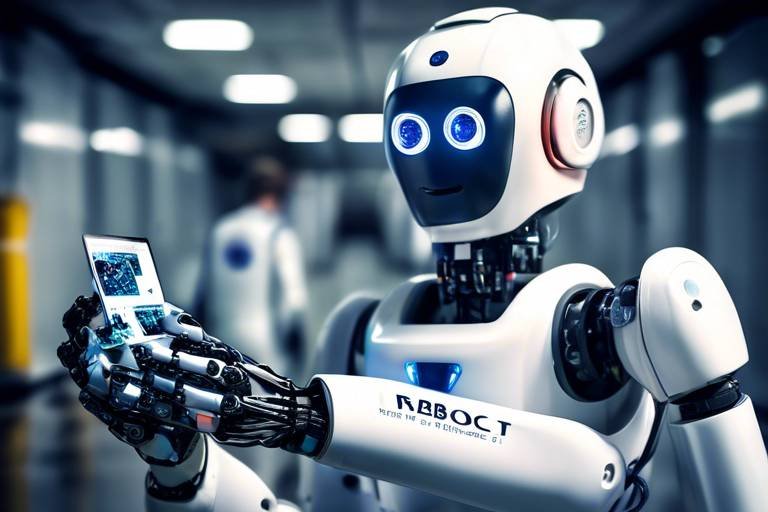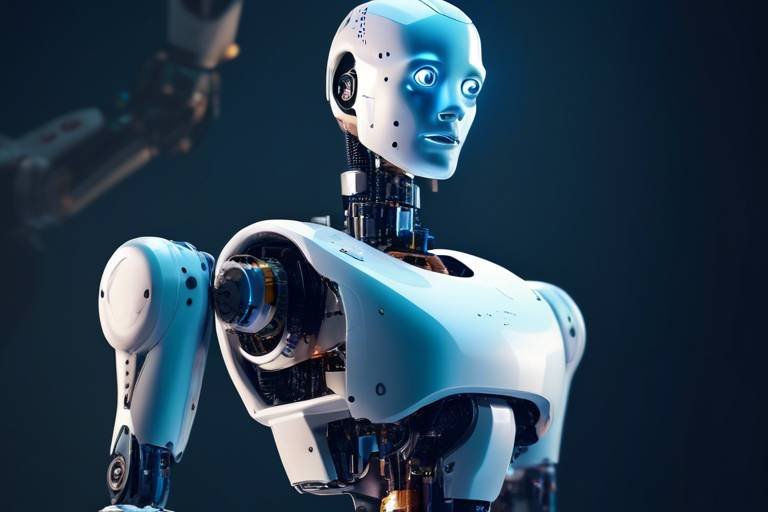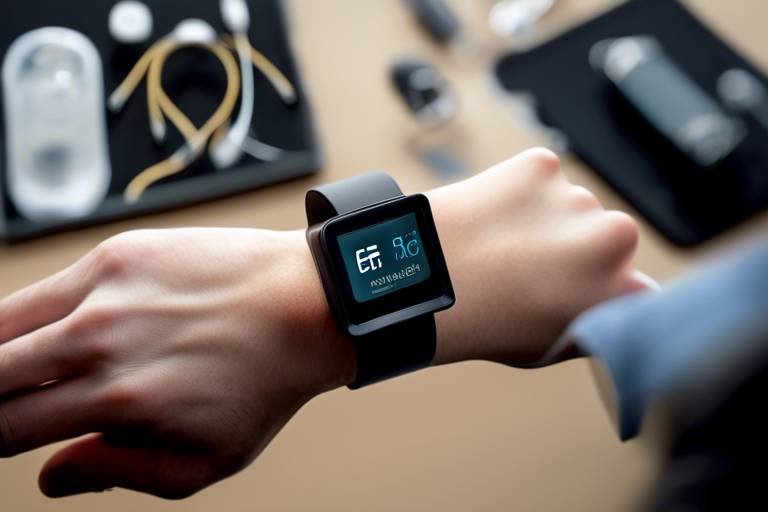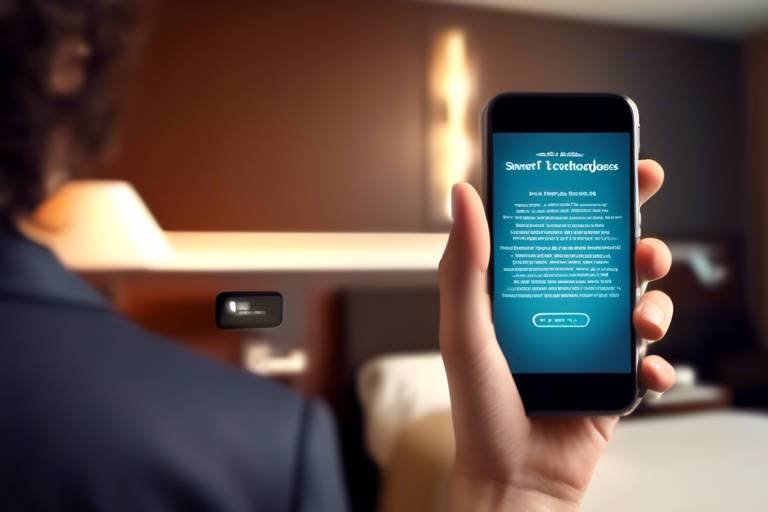How Robotics is Enhancing Emergency Services
In today's fast-paced world, the integration of robotics into emergency services is nothing short of revolutionary. Imagine a scenario where a natural disaster strikes, and within moments, robotic technologies are deployed to assess the situation, locate victims, and provide critical support. This is not just a futuristic dream—it's happening now! Robotics is transforming the landscape of emergency response, enhancing efficiency, safety, and ultimately saving lives.
The role of robotics in emergency services encompasses a wide array of applications, from search and rescue operations to medical emergencies. These advanced systems are designed to operate in environments that are often too dangerous for human responders, allowing for quicker and safer interventions. As we delve deeper into the various applications of robotics in emergency services, we will uncover how these innovations are not only improving response times but also reshaping the way we think about disaster management.
One of the most exciting aspects of robotics in emergency services is the use of autonomous drones. Equipped with cutting-edge sensors and imaging technology, these drones can quickly assess disaster zones, providing real-time data that is crucial for effective decision-making. Imagine a drone soaring over a flood-stricken area, capturing images and relaying vital information back to command centers. This capability allows ground teams to strategize and deploy resources more effectively, ultimately leading to better outcomes for those affected.
Moreover, the use of drones doesn't stop at reconnaissance. They are also being utilized for the delivery of medical supplies to remote or inaccessible locations. In times of crisis, every second counts, and drones can bridge the gap between healthcare providers and patients in need. For instance, during a natural disaster, a drone can transport essential medications or equipment to areas cut off from traditional supply routes, ensuring that help reaches those who need it most.
However, as with any technology, there are challenges to overcome. Issues such as regulatory hurdles, technical limitations, and privacy concerns must be addressed to ensure the safe and effective use of drones in emergency services. It's a balancing act—leveraging the incredible potential of these technologies while ensuring that safety and privacy are not compromised.
As we look to the future, the integration of artificial intelligence (AI) and machine learning into robotic systems promises even greater advancements. Imagine robots that can learn from previous emergencies, improving their performance and decision-making capabilities over time. This evolution will lead to smarter, more efficient emergency responses, ultimately enhancing the safety and well-being of communities.
In conclusion, the transformative role of robotics in emergency services is paving the way for a new era of crisis management. With advancements in technology, we can expect to see continued innovation that not only improves response times but also saves countless lives. As we embrace these changes, the future of emergency services looks brighter than ever.
- What types of robots are used in emergency services?
Emergency services utilize various types of robots, including drones for aerial assessments, ground robots for search and rescue, and robotic systems for medical emergencies.
- How do drones enhance emergency response?
Drones provide rapid assessments of disaster zones, deliver medical supplies, and facilitate communication between ground teams and command centers, making them invaluable in emergencies.
- What are the challenges faced by robotics in emergency services?
Challenges include regulatory hurdles, technical limitations, privacy concerns, and the need for public trust in robotic technologies.
- What is the future of robotics in emergency services?
The future holds promise with advancements in AI, machine learning, and collaborative robots that will enhance efficiency, safety, and effectiveness in crisis response.

Robotic Applications in Search and Rescue
In the face of disasters, whether natural or man-made, the urgency to locate and rescue victims becomes paramount. This is where robotics steps in, acting as a beacon of hope in chaotic scenarios. Robots are increasingly utilized in search and rescue operations, providing critical support in locating victims in disaster-stricken areas and enhancing the safety of human responders in hazardous environments.
Imagine a scenario where a major earthquake has struck a city, leaving buildings in ruins and countless individuals trapped beneath the debris. In such dire situations, human responders face immense risks as they navigate unstable structures and hazardous conditions. Enter search and rescue robots, equipped with advanced sensors and imaging technology. These machines can traverse dangerous terrains, reach areas that are inaccessible to humans, and even operate in environments filled with toxic gases or extreme temperatures.
For instance, ground robots can be deployed to navigate through rubble, using sophisticated cameras and thermal imaging to detect signs of life. They can relay crucial information back to rescue teams, allowing them to strategize their efforts more effectively. In parallel, drone technology has also made significant strides, enabling aerial surveillance that provides a bird's-eye view of the disaster zone. This capability aids in identifying where victims may be trapped and helps in coordinating rescue operations efficiently.
Moreover, the integration of these robotic systems not only enhances the effectiveness of rescue missions but also significantly increases the safety of human responders. By utilizing robots to perform the most dangerous tasks, we minimize the risk to human life. In essence, these robots serve as both searchers and protectors, paving the way for a more efficient and safer rescue operation.
As we look to the future, the potential applications of robotics in search and rescue are vast and exciting. With ongoing advancements in technology, we can expect to see even more sophisticated robots capable of performing complex tasks autonomously. The fusion of artificial intelligence with robotics will enable these machines to learn from their environment and improve their performance over time, making them invaluable assets in emergency situations.
In summary, the role of robotics in search and rescue is not just about technology; it's about saving lives. As these machines continue to evolve, they promise to transform the landscape of emergency response, making our world a safer place in times of crisis.
- How do search and rescue robots operate?
Search and rescue robots are equipped with advanced sensors, cameras, and sometimes even thermal imaging technology. They can navigate dangerous environments, locate victims, and relay information back to human responders. - What are the benefits of using drones in emergency response?
Drones provide aerial views of disaster zones, allowing for rapid assessments and better coordination of rescue efforts. They can also reach areas that may be inaccessible to ground teams. - Are there limitations to robotic applications in search and rescue?
Yes, challenges such as regulatory hurdles, technical limitations, and concerns about privacy and safety need to be addressed for wider adoption of these technologies.

Autonomous Drones for Emergency Response
In the world of emergency services, time is often the most critical factor. When disaster strikes, every second counts, and the ability to assess a situation quickly can mean the difference between life and death. This is where autonomous drones come into play, revolutionizing how we respond to emergencies. Equipped with cutting-edge sensors and imaging technology, these flying robots can rapidly survey disaster zones, providing invaluable data to first responders and command centers.
Imagine a scenario where a natural disaster has just occurred—a massive earthquake, for example. The affected area is chaotic, with damaged buildings, blocked roads, and potentially trapped individuals. In such a situation, deploying drones offers a bird's-eye view of the landscape, allowing emergency teams to pinpoint the most critical areas that need immediate attention. These drones can capture high-resolution images and videos, enabling a thorough assessment of the damage in real-time. This capability not only enhances situational awareness but also aids in the efficient allocation of resources.
Moreover, the integration of real-time communication systems allows drones to relay information back to ground teams almost instantaneously. This seamless communication ensures that responders are equipped with the latest updates, facilitating quicker decision-making processes. For instance, if a drone identifies a group of individuals in distress, ground teams can be dispatched promptly, reducing the time it takes to reach and assist those in need.
But the benefits of autonomous drones extend beyond just aerial surveillance. They can also be programmed to perform specific tasks, such as delivering essential supplies like food, water, and medical kits directly to those in hard-to-reach locations. This capability is especially critical in remote areas where traditional transportation methods may be hindered by debris or damaged infrastructure.
To illustrate the effectiveness of drones in emergency response, consider the following table showcasing the various applications of drones in different emergency scenarios:
| Emergency Scenario | Drone Application | Benefits |
|---|---|---|
| Earthquake | Aerial surveying | Identifies damaged areas and trapped individuals quickly |
| Flooding | Supply delivery | Delivers food and medical supplies to stranded individuals |
| Wildfire | Heat detection | Locates hotspots and assists in firefighting efforts |
| Search and Rescue | Thermal imaging | Helps locate missing persons in challenging terrain |
Despite the numerous advantages, the implementation of autonomous drones in emergency services is not without its challenges. Regulatory hurdles, such as airspace restrictions and safety concerns, must be navigated to ensure that drones can operate effectively during emergencies. Additionally, technical limitations, including battery life and payload capacity, pose obstacles that need to be addressed as technology continues to evolve.
However, the potential of autonomous drones in emergency response is undeniable. As advancements in technology continue to unfold, we can expect these flying robots to become an integral part of our emergency services, enhancing response times and ultimately saving lives in the face of disaster.

Delivery of Medical Supplies
The advent of drones has truly transformed the way we approach emergency medical supply delivery. Imagine a world where essential medications, blood supplies, and medical equipment can reach those in need within minutes, rather than hours. This is not just a dream; it is becoming a reality thanks to the innovative use of drones in emergency services. Drones are equipped with advanced navigation systems and payload capabilities that allow them to deliver critical supplies to remote or disaster-stricken areas, where traditional transport methods may be hindered by damaged infrastructure or treacherous conditions.
One of the most significant advantages of using drones for medical deliveries is their ability to bypass obstacles that would otherwise delay ground transport. For instance, during natural disasters like hurricanes or earthquakes, roads can be blocked by debris, making it nearly impossible for ambulances or delivery trucks to reach those in need. Drones, however, can fly over these barriers, ensuring that medical supplies arrive promptly. This capability not only saves time but can also be the difference between life and death in critical situations.
In addition to speed, drones offer a level of precision that enhances their effectiveness in emergency response. Equipped with GPS and advanced imaging technology, they can pinpoint exact locations for delivery, ensuring that supplies are dropped at the right spot. This is particularly important in chaotic environments where every second counts. Moreover, the use of drones allows for real-time monitoring of supply levels, enabling emergency services to respond dynamically to changing needs.
To illustrate the impact of drone deliveries, consider the following table that outlines some key statistics from recent deployments:
| Location | Type of Supply Delivered | Delivery Time (Minutes) | Traditional Delivery Time (Hours) |
|---|---|---|---|
| Hurricane Relief Zone | Medical Kits | 30 | 4 |
| Remote Village | Vaccines | 15 | 2 |
| Earthquake Site | Blood Supplies | 20 | 3 |
These statistics highlight the efficiency of drone deliveries compared to traditional methods. The rapid deployment of medical supplies not only improves response times but also enhances the overall effectiveness of healthcare delivery during emergencies. However, it’s essential to recognize that while drones are a game-changer, they are not without challenges.
Regulatory hurdles, such as airspace restrictions and safety regulations, can complicate the deployment of drones in emergency situations. Additionally, concerns about privacy and the potential for misuse must be addressed to ensure public trust in this technology. Nevertheless, with ongoing advancements and a clearer regulatory framework, the future of drone deliveries in emergency medical services looks promising.
As we continue to explore the potential of drones, we must also consider their integration with other technologies, such as artificial intelligence and machine learning, to further enhance their capabilities. Together, these innovations can create a robust emergency response system that not only saves lives but also sets a new standard for healthcare delivery in crisis situations.
- How do drones ensure the safe delivery of medical supplies?
Drones are equipped with advanced navigation systems and payload management technology, which allows them to deliver supplies accurately and safely, even in challenging environments. - What types of medical supplies can drones deliver?
Drones can deliver a wide range of medical supplies, including medications, vaccines, blood products, and medical equipment. - Are there any regulations governing the use of drones for medical deliveries?
Yes, the operation of drones is subject to various regulations that govern airspace usage, safety, and privacy. Compliance with these regulations is crucial for the effective deployment of drones in emergency services. - What are the limitations of using drones for medical supply delivery?
Some limitations include payload capacity, regulatory challenges, and potential technical issues such as battery life and connectivity.

Case Studies of Successful Deployments
When it comes to the practical applications of drones in emergency services, the real-world examples are nothing short of remarkable. One notable case occurred during the devastating 2017 hurricane season in Puerto Rico. After Hurricane Maria wreaked havoc, traditional rescue operations faced significant challenges due to damaged infrastructure and treacherous conditions. Enter the drones. Equipped with thermal imaging cameras, these unmanned aerial vehicles (UAVs) were deployed to assess damage and locate stranded individuals in remote areas. The ability to fly over debris and provide real-time data allowed rescue teams to prioritize their efforts and save lives more efficiently.
Another inspiring case took place in 2019 during the Amazon rainforest fires. Drones were utilized to monitor the spread of the flames and assess the impact on wildlife. By gathering data on temperature and smoke density, these drones provided crucial information that helped firefighting teams strategize their response. This innovative use of technology not only enhanced operational efficiency but also contributed to environmental protection efforts, demonstrating how robotics can play a dual role in emergency situations.
In addition to these examples, there have been successful deployments of drones in medical emergencies. For instance, in rural areas of Malawi, drones have been used to deliver blood and medical supplies to clinics that are otherwise difficult to access due to poor road conditions. This initiative has drastically reduced the time it takes to get critical medical resources to those in need, proving that drones can be a game changer in healthcare logistics during emergencies.
To further illustrate the impact of these deployments, the following table summarizes key case studies highlighting the effectiveness of drones in emergency response:
| Case Study | Location | Year | Outcome |
|---|---|---|---|
| Hurricane Maria Rescue Operations | Puerto Rico | 2017 | Improved victim location and assessment of damage |
| Amazon Rainforest Fires Monitoring | Brazil | 2019 | Enhanced firefighting strategy and environmental protection |
| Medical Supply Delivery | Malawi | Ongoing | Reduced delivery time for critical medical supplies |
These case studies underscore the potential of drone technology in emergency services. By providing rapid assessments, facilitating communication, and delivering essential supplies, drones are proving to be invaluable tools in crisis situations. As we continue to explore the capabilities of robotics in emergency response, the lessons learned from these deployments will inform future innovations and strategies, ultimately enhancing the safety and efficiency of emergency services worldwide.
- What types of drones are used in emergency services? Drones used in emergency services typically include reconnaissance drones for damage assessment, delivery drones for medical supplies, and thermal imaging drones for search and rescue operations.
- How do drones improve response times in emergencies? Drones can quickly survey disaster areas, providing real-time data to response teams, which helps them prioritize their actions and allocate resources more effectively.
- Are there any regulations governing the use of drones in emergency services? Yes, the use of drones is subject to regulations that vary by country and region. These regulations often include restrictions on flight paths, altitude, and privacy considerations.
- What challenges do drones face in emergency situations? Challenges include technical limitations, regulatory hurdles, and concerns about safety and privacy. Addressing these issues is crucial for the wider adoption of drone technology in emergency response.

Challenges and Limitations
While the integration of robotics into emergency services is nothing short of revolutionary, it’s important to recognize that this technology is not without its challenges and limitations. As we venture into this new frontier, we must navigate a complex landscape filled with regulatory hurdles, technical limitations, and privacy concerns. Addressing these issues is crucial for the broader adoption of robotic solutions in emergency situations.
One of the most significant challenges is the regulatory environment. Different countries and regions have varying laws and regulations governing the use of drones and robots. For instance, in many places, flying drones in urban areas is heavily restricted, which can hinder their deployment in emergencies. Regulatory bodies are still catching up with the rapid advancements in technology, creating a lag that can delay the implementation of potentially life-saving solutions.
Moreover, the technical limitations of current robotic systems can pose significant barriers. For example, many drones have limited battery life, which restricts their operational range and duration. This limitation can be critical during time-sensitive emergencies where every second counts. Additionally, environmental factors such as weather conditions can severely impact the functionality of these machines. High winds, rain, or snow can render drones ineffective, making it essential for developers to find robust solutions that can withstand various challenges.
Another pressing concern is privacy and safety. As drones and robots become more prevalent in public spaces, the potential for misuse or unintended surveillance increases. Citizens may feel uncomfortable with the idea of being monitored by drones, especially in sensitive situations. It's vital for emergency services to build trust with the communities they serve by implementing strict guidelines and transparency measures regarding how these technologies are used.
To illustrate these challenges more clearly, consider the following table that summarizes key issues faced by emergency robotics:
| Challenge | Description |
|---|---|
| Regulatory Environment | Inconsistent laws and regulations across regions hinder deployment. |
| Technical Limitations | Battery life and environmental factors can restrict operational capabilities. |
| Privacy Concerns | Potential for surveillance raises ethical questions and community trust issues. |
In summary, while the potential of robotics in emergency services is vast, these challenges must be addressed to fully realize their capabilities. By fostering collaboration between technology developers, regulatory bodies, and the communities affected, we can pave the way for a future where robotic assistance becomes a standard part of emergency response, ultimately saving more lives and enhancing safety for all.
- What are the main challenges facing robotics in emergency services?
The main challenges include regulatory hurdles, technical limitations, and privacy concerns. - How do regulations impact the use of drones in emergencies?
Regulations can restrict where and how drones can be operated, which can delay their deployment in critical situations. - What technical limitations do current robotic systems face?
Many systems, such as drones, have limited battery life and can be affected by adverse weather conditions. - How can privacy concerns be addressed in emergency robotics?
Implementing strict guidelines and transparency measures can help build trust with the community regarding the use of robotic technologies.

Robotic Assistance in Firefighting
When it comes to firefighting, the stakes are incredibly high. Every second counts, and the risks faced by human firefighters are immense. Enter robotic assistance, a game-changing innovation that is redefining how we tackle fires. These advanced machines are designed to navigate hazardous environments, providing crucial support that not only enhances the effectiveness of firefighting efforts but also significantly improves the safety of human responders.
Imagine a robot that can enter a burning building before any human steps foot inside. These robots are equipped with state-of-the-art sensors and imaging technology, allowing them to detect heat sources and assess structural integrity in real-time. This capability is vital because it enables firefighters to make informed decisions about how to approach a fire, ultimately saving lives and property.
One of the standout features of firefighting robots is their ability to extinguish flames autonomously. They can be deployed to spray water or fire retardants in areas that are too dangerous for human crews. This not only helps to control the fire more effectively but also reduces the risk of injury to firefighters. The integration of robotic technology in firefighting operations is akin to having a highly skilled assistant who can handle the most dangerous tasks while humans focus on strategy and rescue operations.
Moreover, these robots can be remotely operated, allowing a safe distance between the fire and the responders. This aspect is particularly crucial during large-scale fires or wildfires, where conditions can change rapidly. The ability to control a robot from a safe location ensures that human lives are prioritized while still effectively combating the blaze.
However, just like any technology, firefighting robots are not without challenges. They must be designed to withstand extreme temperatures and rugged environments. Additionally, the cost of deploying these robots can be significant, which may limit their availability, especially in smaller fire departments. Yet, the long-term benefits of integrating robotic assistance into firefighting strategies far outweigh these challenges.
In conclusion, the future of firefighting is undoubtedly intertwined with robotics. As technology continues to advance, we can expect to see even more sophisticated robots that can assist in firefighting efforts, making our communities safer. The combination of human expertise and robotic precision could very well be the key to revolutionizing how we respond to fires in the years to come.
- What types of robots are used in firefighting? Firefighting robots can include ground-based units that navigate through smoke and debris, drones for aerial surveillance, and even robotic arms for extinguishing fires.
- How do firefighting robots improve safety? They reduce the need for human firefighters to enter dangerous environments, allowing them to assess and manage situations from a safe distance.
- Are firefighting robots expensive? Yes, the initial investment can be high, but the long-term savings in terms of reduced injuries and improved efficiency can justify the cost.
- Can robots operate in extreme temperatures? Yes, firefighting robots are designed with materials that can withstand high temperatures, enabling them to function effectively in harsh conditions.

Robotics in Medical Emergencies
In the fast-paced world of medical emergencies, every second counts. The advent of robotics in this field has been nothing short of revolutionary, enhancing patient care in ways we could only dream of a few decades ago. Imagine a scenario where a patient is in critical condition, and traditional methods of treatment are either too slow or ineffective. This is where robotic systems step in, providing advanced monitoring and telemedicine capabilities that can make a significant difference in outcomes.
Robotic technology in medical emergencies serves multiple purposes. For instance, robotic systems can assist in life-saving procedures, offering precision that human hands alone might not achieve under pressure. These systems can be equipped with advanced imaging technologies, allowing medical professionals to visualize the internal structures of a patient in real time, thereby facilitating quicker and more accurate interventions.
One of the most notable advancements in this area is the use of telepresence robots. These robots enable healthcare professionals to conduct remote consultations, ensuring that patients in remote or disaster-stricken areas receive timely care. Imagine a doctor in a city hundreds of miles away guiding a local paramedic through a complex procedure via a telepresence robot. This type of technology not only bridges the gap between patients and specialists but also optimizes the use of medical resources, ensuring that expert guidance is always within reach.
Moreover, the integration of robotic surgical systems into emergency medicine has transformed how we approach critical surgical interventions. These robots can perform intricate procedures with enhanced precision, reducing the risk of complications and minimizing recovery time for patients. Think of it as having a highly skilled assistant who can operate with unparalleled accuracy, allowing surgeons to focus on the broader aspects of patient care.
However, the implementation of robotics in medical emergencies is not without its challenges. Factors such as cost, training for medical personnel, and the need for robust technological infrastructure can hinder widespread adoption. Nevertheless, the benefits far outweigh these challenges, as the potential for improved patient outcomes and enhanced efficiency in emergency services is immense.
As we look to the future, it’s clear that robotics will continue to play an integral role in medical emergencies. The ongoing advancements in technology, coupled with the increasing acceptance of robotic assistance in healthcare, promise a future where emergency medical services are not only faster but also more effective. With robotics, we are not just enhancing our response capabilities; we are fundamentally changing the way we deliver care in the most critical moments.
- What are telepresence robots? Telepresence robots are devices that allow healthcare professionals to provide remote consultations and care, bridging the gap between patients and specialists regardless of their physical location.
- How do robotic surgical systems improve patient outcomes? Robotic surgical systems enhance precision during procedures, which can lead to fewer complications, shorter recovery times, and overall better patient outcomes.
- What challenges does the integration of robotics face in medical emergencies? Challenges include high costs, the need for specialized training for medical personnel, and the requirement for a robust technological infrastructure.
- Will robotics replace human healthcare providers? No, robotics are designed to assist and enhance the capabilities of human providers, not replace them. They work best in collaboration with medical professionals.

Telepresence Robots for Remote Consultations
In the fast-paced world of emergency medicine, time is often of the essence. This is where telepresence robots come into play, revolutionizing the way healthcare professionals interact with patients in critical situations. Imagine a scenario where a patient is in a remote location, unable to reach a hospital due to natural disasters or other emergencies. Instead of waiting for help to arrive, a telepresence robot can bridge that gap, allowing medical experts to provide immediate consultations from afar. These robots are equipped with high-definition cameras, microphones, and speakers, enabling real-time communication that feels almost as if the doctor is right there in the room.
The benefits of using telepresence robots in emergency situations are profound. They not only facilitate rapid assessments but also ensure that patients receive timely care without the delay of transportation. For instance, during a disaster, a telepresence robot can be deployed to the scene, enabling doctors to diagnose and recommend treatment plans while observing the patient's condition remotely. This is particularly crucial in situations where every second counts, such as in cases of severe trauma or respiratory distress.
Moreover, these robots can be programmed to assist in various ways, including:
- Providing visual and auditory support for medical teams on the ground.
- Offering guidance on procedures through live video feeds.
- Collecting vital signs and other patient data for analysis.
As we look to the future, the integration of telepresence robots into emergency medical services promises to enhance not only the efficiency of healthcare delivery but also the overall patient experience. These robots can alleviate the burden on human responders, allowing them to focus on hands-on care while technology assists in the background. However, it's important to note that while these robots can provide invaluable support, they are not a replacement for human interaction. The empathy, understanding, and nuanced care that a human doctor provides are irreplaceable, but telepresence robots can certainly enhance the overall medical response in emergencies.
In summary, telepresence robots represent a significant leap forward in emergency medical services. They offer the potential to transform how we deliver care in urgent situations, making healthcare more accessible and timely for everyone, regardless of their location. As technology continues to evolve, we can expect to see even more innovative applications of telepresence robots, ultimately saving lives and improving patient outcomes in emergencies.
- What are telepresence robots?
Telepresence robots are robotic devices equipped with cameras, microphones, and speakers that allow remote communication between healthcare professionals and patients.
- How do telepresence robots improve emergency care?
They enable real-time consultations, allowing doctors to assess and guide treatment without needing to be physically present, which can save critical time.
- Are telepresence robots effective in all emergency situations?
While they are incredibly useful, their effectiveness can depend on the specific circumstances and the nature of the emergency.
- Can telepresence robots replace human doctors?
No, they are designed to assist and enhance human care, not replace the essential empathy and judgment that healthcare professionals provide.

Robotic Surgery in Emergency Situations
In the high-stakes world of emergency medicine, every second counts, and the integration of robotic surgery is proving to be a game-changer. Imagine a scenario where a patient arrives at the emergency room with life-threatening injuries. Traditional surgical methods can be time-consuming and risky, but with robotic assistance, surgeons can perform procedures with enhanced precision and speed. This technology not only minimizes the time spent in surgery but also significantly reduces recovery times, allowing patients to get back on their feet faster than ever before.
Robotic surgical systems are equipped with advanced tools that provide surgeons with a 3D view of the surgical field, enabling them to operate with unparalleled accuracy. The robotic arms can maneuver in ways that human hands cannot, allowing for intricate movements that are essential in delicate procedures. For instance, in cases of internal bleeding or traumatic injuries, robotic systems can assist in quickly identifying and repairing damaged tissues, which is crucial for patient survival.
Moreover, the benefits of robotic surgery extend beyond just the operating room. These systems can facilitate remote surgeries through telemedicine, where a specialist can guide the robotic instruments from a distance. This is particularly valuable in emergency situations where expert surgeons may not be immediately available. Imagine a scenario where a patient in a rural area requires urgent surgery; a skilled surgeon from a metropolitan hospital can virtually step in to direct the robotic system, ensuring that the patient receives the best care possible, regardless of their location.
However, as with any technology, there are challenges to consider. The cost of robotic surgical systems can be significant, and not all hospitals have the resources to invest in this cutting-edge technology. Additionally, there is a learning curve for surgeons who must be trained to operate these sophisticated machines. Yet, the advantages they offer, particularly in emergency situations, make them a worthwhile investment for many healthcare facilities.
As we look to the future, the potential for robotic surgery in emergency medicine appears limitless. With ongoing advancements in technology, we can expect to see even more refined systems that enhance surgical capabilities. For instance, the incorporation of artificial intelligence could lead to smarter robotic systems that assist in decision-making during critical procedures. This could further improve patient outcomes and transform the landscape of emergency healthcare.
In conclusion, robotic surgery is not just a trend; it is a revolutionary approach that is reshaping how we respond to medical emergencies. By combining speed, precision, and expert guidance, robotic systems are enhancing surgical outcomes and saving lives. As technology continues to evolve, we can anticipate even more remarkable advancements that will further solidify the role of robotics in emergency medicine.
- What is robotic surgery?
Robotic surgery involves the use of robotic systems to assist surgeons in performing minimally invasive procedures with greater precision and control.
- How does robotic surgery improve patient outcomes?
Robotic surgery can lead to shorter recovery times, less pain, and reduced risk of complications compared to traditional surgical methods.
- Are there any risks associated with robotic surgery?
As with any surgical procedure, there are risks involved, including potential complications from anesthesia and the surgery itself. However, robotic surgery is generally considered safe.
- Can robotic surgery be performed remotely?
Yes, robotic surgery can be conducted remotely, allowing specialists to guide robotic systems from different locations, which is especially beneficial in emergencies.

Future Trends in Emergency Robotics
The landscape of emergency services is on the brink of a **revolution**, thanks to the rapid advancements in robotics. As we look towards the future, it becomes increasingly clear that robotics will play a pivotal role in enhancing the efficiency and effectiveness of emergency response teams. Imagine a world where robots and humans work side by side, each complementing the other's strengths to tackle crises more effectively. This vision is becoming a reality as we explore the integration of **artificial intelligence (AI)** and **machine learning** into robotic systems.
One of the most exciting trends is the incorporation of AI algorithms that enable robots to make decisions in real-time. This capability allows for improved situational awareness, as robots can analyze data from various sources and adapt their actions accordingly. For instance, during a natural disaster, an AI-powered robot could assess the conditions of the environment, identify areas of risk, and prioritize rescue operations based on the urgency of the situation. This **smart decision-making** not only enhances the safety of human responders but also increases the likelihood of saving lives.
Furthermore, the development of **collaborative robots**, or **cobots**, is set to transform emergency response teams. These robots are designed to work alongside human responders, enhancing operational efficiency. Picture a scenario where a cobot assists firefighters by carrying heavy equipment or navigating through hazardous conditions, allowing human firefighters to focus on strategy and decision-making. The synergy between humans and cobots will not only streamline operations but also ensure that resources are allocated more effectively, ultimately leading to better outcomes in crisis situations.
As we delve deeper into the future of emergency robotics, we can expect to see a growing emphasis on **autonomous systems**. These robots will be capable of performing tasks independently, such as conducting search and rescue missions in areas that are too dangerous for human responders. For example, a drone equipped with advanced imaging technology could autonomously survey a disaster zone, identifying survivors and relaying critical information back to command centers. This level of autonomy will drastically reduce response times and enhance the overall effectiveness of emergency operations.
Moreover, the integration of **telecommunication technologies** with robotics will facilitate real-time communication between ground teams and command centers. Imagine drones equipped with **live streaming capabilities**, allowing emergency personnel to see the situation from above and make informed decisions on the ground. This level of connectivity will not only improve coordination but also ensure that responders have access to the most up-to-date information, enabling them to act swiftly and effectively.
However, as we embrace these advancements, it is crucial to address the **challenges** that come with them. Issues such as regulatory compliance, privacy concerns, and the need for robust training programs for responders must be tackled to ensure the successful implementation of robotic technologies in emergency services. Nevertheless, the potential benefits far outweigh the challenges, and with ongoing research and development, the future of emergency robotics looks promising.
- What are collaborative robots?
Collaborative robots, or cobots, are designed to work alongside humans, enhancing operational efficiency in various tasks, particularly in emergency response situations. - How will AI improve emergency robotics?
AI will enable robots to make smarter decisions based on real-time data, improving situational awareness and response times during emergencies. - What challenges do emergency robotics face?
Challenges include regulatory compliance, privacy concerns, and the need for effective training programs for responders to work alongside robotic systems. - Can robots operate autonomously in emergencies?
Yes, future robotic systems are being developed to operate autonomously, enabling them to conduct tasks such as search and rescue without human intervention.

Integration with AI and Machine Learning
As we step into a new era of technology, the integration of AI and machine learning into robotics is reshaping the landscape of emergency services. Imagine a scenario where robots not only assist human responders but also learn from past experiences to improve their performance in real-time. This is not a distant future; it’s happening now, and it’s revolutionizing how we approach emergencies.
AI and machine learning empower robots to analyze vast amounts of data quickly. For example, during a natural disaster, a robot equipped with these technologies can process information from various sensors, including thermal imaging and environmental data, to identify the safest routes for rescue operations. This ability to adapt and make informed decisions on the fly is crucial when every second counts.
Moreover, the predictive capabilities of AI can significantly enhance situational awareness. By analyzing patterns from previous incidents, robots can forecast potential hazards and suggest preventive measures. This proactive approach not only saves lives but also reduces the risk to human responders, allowing them to focus on critical tasks without unnecessary exposure to danger.
To illustrate the impact of AI and machine learning in emergency robotics, consider the following table that highlights key benefits:
| Benefit | Description |
|---|---|
| Enhanced Decision-Making | Robots can analyze data and make real-time decisions, improving response times. |
| Increased Safety | AI helps identify risks, allowing human responders to avoid dangerous situations. |
| Resource Optimization | Machine learning algorithms can allocate resources more effectively based on situational needs. |
| Continuous Learning | Robots can learn from each mission, improving their efficiency and effectiveness over time. |
Furthermore, the collaboration between human responders and robots, often referred to as collaborative robotics, is set to redefine team dynamics in emergency scenarios. These cobots are designed to work alongside humans, enhancing operational efficiency while ensuring safety. By sharing information and tasks, they create a synergistic environment where both robots and humans can thrive.
In conclusion, the integration of AI and machine learning into robotics is not just a technological advancement; it’s a game-changer for emergency services. As these technologies continue to evolve, we can expect even more innovative solutions that will enhance our ability to respond to crises, ultimately saving lives and making our communities safer.
- What is the role of AI in emergency robotics?
AI enhances the decision-making capabilities of robots, allowing them to analyze data and respond to situations in real-time.
- How do collaborative robots improve emergency response?
Collaborative robots work alongside human responders, optimizing resource allocation and increasing operational efficiency.
- Can robots learn from past emergencies?
Yes, robots equipped with machine learning algorithms can analyze past incidents to improve their performance in future emergencies.

Collaborative Robots in Emergency Teams
In the realm of emergency services, the introduction of collaborative robots, often referred to as cobots, is nothing short of revolutionary. These innovative machines are designed to work seamlessly alongside human responders, significantly enhancing operational efficiency and safety in high-pressure situations. Imagine a scenario where a firefighter is battling flames, and a robotic assistant is right there, providing real-time data on heat levels and structural integrity. This is not science fiction; it's the reality of modern emergency response.
The beauty of cobots lies in their ability to take on tasks that are either too dangerous or too tedious for humans. For example, in a search and rescue operation, a cobot can navigate through rubble, using advanced sensors to locate victims while human rescuers focus on extracting them safely. This collaboration not only increases the chances of saving lives but also reduces the risk to human responders. It’s like having a trusted partner who can handle the heavy lifting while you strategize the next move.
Moreover, the integration of cobots into emergency teams is not just about physical tasks; it's also about enhancing communication and coordination. These robots can share critical information with human team members in real-time, ensuring that everyone is on the same page. For instance, a cobot equipped with imaging technology can relay live feeds from a disaster site back to a command center, allowing decision-makers to assess the situation more accurately and allocate resources more effectively.
However, the successful implementation of collaborative robots in emergency teams does come with its own set of challenges. Training personnel to work alongside these machines is essential. Teams must learn not only how to operate the robots but also how to trust them in high-stakes situations. Just as a well-rehearsed dance routine requires both partners to be in sync, so too does the collaboration between humans and robots in emergency services.
As we look to the future, the potential for cobots in emergency response continues to grow. With advancements in artificial intelligence and machine learning, these robots will become even smarter, capable of making decisions based on real-time data and adapting to changing environments. The landscape of emergency services is evolving, and collaborative robots are at the forefront of this transformation, paving the way for a safer and more efficient response to crises.
- What are collaborative robots?
Collaborative robots, or cobots, are designed to work alongside human workers to enhance efficiency and safety, particularly in high-risk environments like emergency services. - How do cobots improve emergency response?
Cobots can perform dangerous tasks, provide real-time data, and assist in communication, all of which help human responders focus on critical decisions and actions. - Are there any challenges associated with using cobots?
Yes, challenges include the need for proper training and the integration of these robots into existing emergency response protocols. - What is the future of cobots in emergency services?
With advancements in AI and machine learning, cobots will become smarter and more capable, further enhancing their role in emergency response.
Frequently Asked Questions
-
How are robots used in search and rescue operations?
Robots play a vital role in search and rescue operations by providing support in locating victims in disaster-stricken areas. They can navigate hazardous environments where human responders might be at risk, using advanced sensors and imaging technology to identify survivors and assess situations quickly.
-
What advantages do drones offer in emergency response?
Drones equipped with advanced sensors enable rapid assessment of disaster zones. They facilitate real-time communication between ground teams and command centers, allowing for quicker decision-making and more efficient resource allocation. Additionally, drones can deliver medical supplies to remote or inaccessible locations, ensuring timely access to critical resources during emergencies.
-
What are some challenges faced by drones in emergency services?
Despite their many advantages, the use of drones in emergency services faces challenges such as regulatory hurdles, technical limitations, and privacy concerns. Addressing these issues is crucial for the wider adoption of drones in emergency response scenarios.
-
How do robotic systems enhance medical emergencies?
Robotic systems are increasingly integrated into medical emergency services, improving patient care through advanced monitoring and telemedicine capabilities. They can assist in life-saving procedures, ensuring that patients receive timely and expert care, even in critical situations.
-
What is the role of telepresence robots in emergencies?
Telepresence robots allow medical professionals to provide remote consultations during emergencies. This ensures that patients receive immediate care and expert guidance, regardless of their location, which can be crucial in life-threatening situations.
-
What future trends can we expect in emergency robotics?
The future of robotics in emergency services is bright, with advancements in AI and machine learning expected to enhance decision-making and situational awareness. Collaborative robots, or cobots, will also play a significant role by working alongside human responders, increasing efficiency and safety in emergency operations.



















